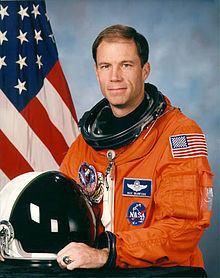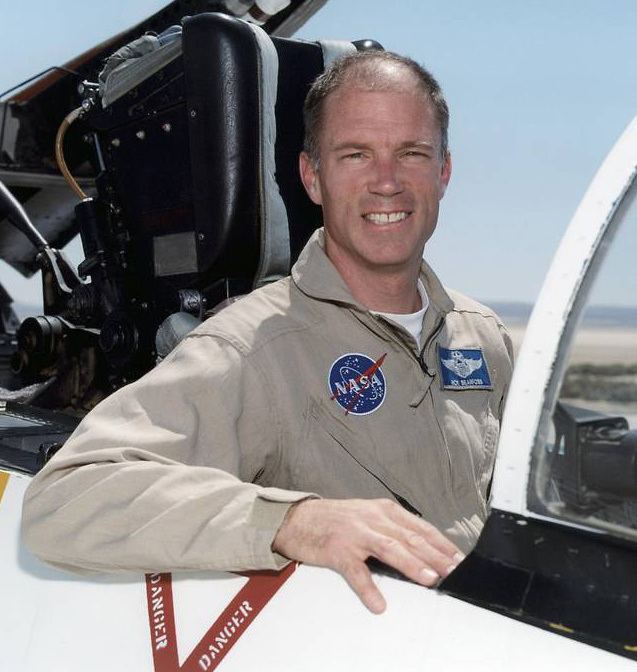Nationality American Status Retired Name Richard Searfoss | Role Astronaut Movies Green Lantern Other occupation Test pilot | |
 | ||
Alma mater USAFA, B.S. 1978CalTech, M.S. 1979 Education Similar People Linda M Godwin, Shannon Lucid, Ronald M Sega, Kevin P Chilton, Michael R Clifford | ||
Other names Richard Alan Searfoss | ||
1998: Space Shuttle Flight 90 (STS-90) Columbia (NASA)
Richard Alan Searfoss (born June 5, 1956) is a retired United States Air Force colonel, NASA astronaut and test pilot.
Contents
- 1998 Space Shuttle Flight 90 STS 90 Columbia NASA
- Early life
- Air Force service
- NASA service
- Civilian space
- Honors and awards
- Organizations
- References

Early life

Searfoss was born on June 5, 1956, in Mount Clemens, Michigan, but considers Portsmouth, New Hampshire, to be his hometown. Growing up, he became an Eagle Scout.

After graduating from Portsmouth Senior High School, Portsmouth, New Hampshire in 1974, he received a Bachelor of Science degree in Aeronautical Engineering from the United States Air Force Academy in 1978, and a Master of Science degree in Aeronautics from the California Institute of Technology on a National Science Foundation Fellowship in 1979. In the Air Force, he attended Squadron Officer School, Air Command and Staff College, and Air War College.
Air Force service

Searfoss graduated in 1980 from Undergraduate Pilot Training at Williams Air Force Base, Arizona. From 1981-1984, he flew the F-111F operationally at RAF Lakenheath, England, followed by a tour at Mountain Home Air Force Base, Idaho, where he was an F-111A instructor pilot and weapons officer until 1987. In 1988 he attended the U.S. Naval Test Pilot School, Patuxent River, Maryland, as a USAF exchange officer. He was a flight instructor at the U.S. Air Force Test Pilot School at Edwards Air Force Base, California, when selected for the astronaut program.
He has logged over 6,000 hours flying time in 77 different types of aircraft and over 939 hours in space. He also holds FAA Airline Transport Pilot, glider, and flight instructor ratings.
NASA service
Selected by NASA in January 1990, Searfoss became an astronaut in July 1991. Initially assigned to the Astronaut Office Mission Support Branch, Searfoss was part of a team responsible for crew ingress/strap-in prior to launch and crew egress after landing. He was subsequently assigned to flight software verification in the Shuttle Avionics Integration Laboratory (SAIL). Additionally, he served as the Astronaut Office representative for both flight crew procedures and Shuttle computer software development. He also served as the Astronaut Office Vehicle System and Operations Branch Chief, leading a team of several astronauts and support engineers working on Space Shuttle and International Space Station systems development, rendezvous and landing/rollout operations, and advanced projects initiatives.
Searfoss served as STS-58 pilot on the seven-person life science research mission aboard the Space Shuttle Columbia, launching from the Kennedy Space Center on October 18, 1993, and landing at Edwards Air Force Base on November 1, 1993. The crew performed neurovestibular, cardiovascular, cardiopulmonary, metabolic, and musculoskeletal medical experiments on themselves and 48 rats, expanding our knowledge of human and animal physiology both on earth and in space flight. In addition, the crew performed 16 engineering tests aboard the Orbiter Columbia and 20 Extended Duration Orbiter Medical Project experiments. The mission was accomplished in 225 orbits of the Earth.
Searfoss flew his second mission as pilot of STS-76 aboard the Space Shuttle Atlantis, which launched at night on March 22, 1996. During this 9-day mission the STS-76 crew performed the third docking of an American spacecraft with the Russian space station Mir. In support of a joint U.S./Russian program, the crew transported to Mir nearly two tons of water, food, supplies, and scientific equipment, as well as U.S. Astronaut Shannon Lucid to begin her six-month stay in space. STS-76 included the first ever spacewalk on a combined Space Shuttle-Space Station complex. The flight crew also conducted scientific investigations, including European Space Agency sponsored biology experiments, the Kidsat earth observations project, and several engineering flight tests. Completed in 145 orbits, STS-76 landed at Edwards Air Force Base, California, on March 31, 1996.
Searfoss commanded a seven-person crew on the STS-90 Neurolab mission which launched on April 17, 1998. During the 16-day Spacelab flight the crew served as both experiment subjects and operators for 26 individual life science experiments focusing on the effects of microgravity on the brain and nervous system. STS-90 was the last and most complex of the twenty-five Spacelab missions NASA has flown. Neurolab's scientific results will have broad applicability both in preparing for future long duration human space missions and in clinical applications on Earth. Completed in 256 orbits, STS-90 landed at Kennedy Space Center, Florida, on May 3, 1998.
A veteran of three space flights, Searfoss logged over 39 days in space. He retired from the Air Force and left NASA in 1998. For the next few years, he continued to work as a contract research test pilot at NASA’s Dryden Flight Research Center.
Civilian space
After leaving NASA, Searfoss served as a judge for the Ansari X-Prize, where he officially declared SpaceShipOne to have won the competition on October 4, 2004 after completing two flights within a two-week period.
Searfoss is a test pilot instructor at the National Test Pilot School at the Mojave Spaceport.
In 2008, he was a featured guest in a Volkswagen commercial, where he argued with a black Beetle about who has more engineers between Volkswagen and NASA.
Since the mid-2000s, Searfoss has been working with XCOR Aerospace in the development of their rocket-powered aircraft. As of September 2013, he is Chief Test Pilot at XCOR. He flew the flight tests and envelope expansion of the EZ-Rocket. He also served as XCOR's only test pilot for a rocket-powered prototype racing aircraft. He has a total of 52 rocket-powered flights and is the world's only tri-qualified rocket pilot (Space Shuttle, EZ Rocket, Rocket Racer prototype).
